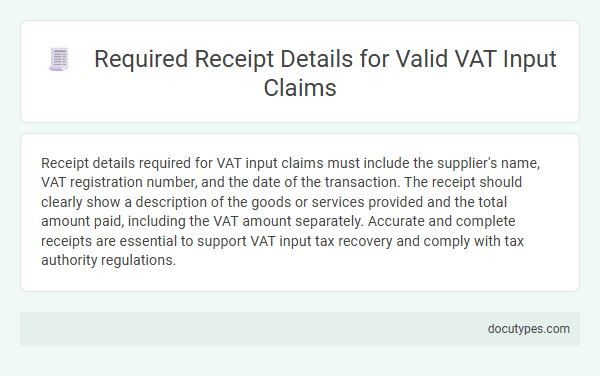Receipt details required for VAT input claims must include the supplier's name, VAT registration number, and the date of the transaction. The receipt should clearly show a description of the goods or services provided and the total amount paid, including the VAT amount separately. Accurate and complete receipts are essential to support VAT input tax recovery and comply with tax authority regulations.
Introduction to VAT Input Claims
VAT input claims allow businesses to reclaim the Value Added Tax paid on purchases related to their taxable activities. Proper documentation is essential to ensure these claims are valid and accepted by tax authorities.
Your receipt must include specific details such as the supplier's name, VAT registration number, date of issue, and the total amount including VAT. Accurate and complete receipt information supports compliance and smooth processing of VAT input claims.
Importance of Accurate Receipts for VAT
Accurate receipt details are essential for claiming VAT input tax correctly. Ensuring your receipts contain all necessary information helps avoid claims being rejected.
- Supplier Information - Receipts must include the supplier's name, address, and VAT registration number to validate the transaction.
- Transaction Details - The date of supply, description of goods or services, and total amount including VAT are critical for accurate tax reporting.
- VAT Amount - Clear indication of the VAT charged ensures the correct input tax can be reclaimed.
Basic Receipt Information Required
To claim VAT input, your receipt must include essential details such as the supplier's name, address, and VAT registration number. The date of issue and a clear description of the goods or services supplied are also crucial. Without these basic receipt information, your VAT input claim may be rejected by tax authorities.
Supplier Identification Details
For VAT input claims, accurate receipt details are essential to validate your purchases. Supplier identification details on the receipt ensure compliance with tax regulations and support your claim.
- Supplier Name - The official registered name of the supplier must be clearly stated.
- Supplier VAT Number - The receipt should include the supplier's VAT registration number to verify the legitimacy of the transaction.
- Supplier Address - A complete address of the supplier helps confirm the business location associated with the VAT claim.
Ensuring your receipt contains these supplier identification details helps prevent rejection of your VAT input claims by tax authorities.
VAT Registration Number Requirements
When claiming VAT input tax, the receipt must include specific details to be valid. One crucial detail is the VAT registration number of the supplier, which confirms their VAT-registered status.
This VAT registration number must be clearly displayed and accurate for the claim to be accepted. Without it, tax authorities may reject the input VAT claim, causing compliance issues.
Transaction Date and Invoice Number
For VAT input claims, the receipt must clearly display the transaction date to verify the timing of the purchase. The invoice number is essential to uniquely identify the transaction and support accurate record-keeping. Both details ensure compliance with tax authorities and facilitate proper VAT reclaim processing.
Itemized Description of Goods or Services
For VAT input claims, the receipt must include an itemized description of all goods or services purchased. Clear details help verify the nature and validity of the expenses for tax purposes.
- Detailed Itemization - Each product or service must be listed separately to distinguish different taxable items.
- Accurate Descriptions - Descriptions should specify quantities, unit prices, and types of goods or services provided.
- Compliance with Tax Regulations - Receipts must follow local VAT rules to ensure your claim is accepted by tax authorities.
VAT Amount and Rate Specification
For VAT input claims, receipt details must clearly specify the VAT amount and rate. Accurate identification of these elements ensures compliance with tax authorities.
Receipts must display the VAT rate applied to the purchase, typically as a percentage. The VAT amount should be itemized separately from the total cost, making it easy to verify claim eligibility. Proper documentation of both rate and amount supports audit accuracy and claim validity.
Buyer Details for Input Claims
| Receipt Details Required for VAT Input Claims | |
|---|---|
| Buyer Details | Accurate buyer information is essential for validating VAT input claims. The receipt must clearly display Your registered business name and VAT identification number. Including Your full address ensures compliance with tax authority requirements. Contact information, such as a phone number or email, may also be necessary for verification purposes. These details authenticate the purchase and establish Your entitlement to reclaim VAT. |
| Seller Details | Receipts must include the seller's business name, registered address, and VAT number to support VAT input claims. This information confirms the legitimacy of the transaction and the seller's VAT registration status. |
| Transaction Information | The receipt should list the date of purchase, a detailed description of goods or services, quantities, unit prices, total amount payable, and the VAT amount charged. Clear VAT rates applied must be visible to substantiate the VAT amount claimed as input tax. |
What Receipt Details Are Required for VAT Input Claims? Infographic

